Everything you want (or need) to do starts with an idea.
It could be an idea for a new project, it could be a plan for a trip, it could be a college application, or it could be a task you are given and you need to figure out how to start it.
Whatever the situation, you need a way to take that idea and turn it into something: an action, an output, an outcome — a result.
In this article, I’m going to take you through a workflow to do just that. I first started thinking about this concept way back in 2012 (!), when I listened to a podcast episode titled Cooking Ideas where host David Sparks laid out his process. Over the years, I have adapted it to what works for me, and I encourage you to do the same.
Some Notes Before We Begin
A few years ago, I attended a virtual talk by Janet Murray, and after the introduction, she started with what I thought was a brilliant question:
Do you believe it’s possible to learn from experiences that don’t directly relate to your own?
She asked that to get buy-in from the attendees before she shared a business example because many attendees were not business owners.
I would like to take this opportunity to ask you the same question, for two reasons:
- Many of the apps and automation examples will be from the Apple platform. When possible, I will share cross-platform examples too, but some of the apps are Apple-only. However, the concepts can be applied anywhere: paper, digital, Mac, Windows, iOS, Android.
- Some of my examples will come from what I do: writing, resource creation, and content creation. It may be that you don’t do any of those in your life. That’s OK! Again, the concepts can be applied to ideas and tasks of any type.
Whatever you do with your ideas, I will be sharing an idea to results workflow that has three main parts:
- 📝 Generate & Capture Ideas
- 🏗 Build Out & Develop Those Ideas
- ⚡️ Turn Those Ideas Into Action
Ideas are everywhere
Here’s the great thing about ideas: they are everywhere. If you’re a writer, a podcaster, an academic, a course creator, a D&D DM, or someone who creates content, topic ideas are all over the place.
Even in a corporate job, improvement ideas, new projects, and ways to stand out in your job are around you, if you choose to look for them.
Ideas are everywhere, but most people don’t notice them. That’s an opportunity for you.
Finding these ideas takes 2 things:
A curiosity mindset
When you are open to ideas, you’ll see them every day. You may not end up using all of them, but the more you notice, the more you have to draw on. The more you see, the more you will see, so start practicing today with open eyes and a curiosity mindset.
For example, my hometown was rated by a magazine as the worst place to live in Canada. (Yeah! We’re #1!). Here’s what popped into my head after reading that:

I haven’t used it yet, but if you sign up for the Asian Efficiency newsletter, there’s a good chance someday you will see it.
A way to quickly capture those ideas
We’ll talk more about capturing ideas in a moment, but speed is so critical. You need a way to quickly get ideas and tasks out of your head and into a trusted system. If you don’t, they’ll be gone.
It reminds me of a Tweet by Nick Milo, who (spoiler alert) is an upcoming guest on The Productivity Show:

Substitute notion for idea, and you can see that you’re one distraction away from losing something potentially life-changing.
As an example, I had the initial idea for the title for this article in the shower this morning. The first thing I did after getting out was grab my phone and note it down.

I knew if I waited until later, it would be gone. Will that be the final title? Probably not, but by capturing the initial idea, I have somewhere to start from.
How To Capture Your Ideas 📝
I have two rules for capturing ideas:
- It needs to be fast
- You need to do what works for you
There’s no “right” way to capture ideas. It could be:
- A cheap notebook from the supermarket
- A compact Field Notes notebook
- A nice Bullet Journal
- A mobile app
- A desktop app
We’ve written about the importance of Capture before, and have recorded a podcast about it. I’ve even written about capturing ideas while driving, showering, exercising, and other challenging situations.
More often than not, I use an app called Drafts, which is available on iPhone, iPad, Mac, and Apple Watch.
I like it because it is extremely fast to launch, easy to use, has good voice support, and has amazing integrations and automation.
For example, this article started in Drafts:
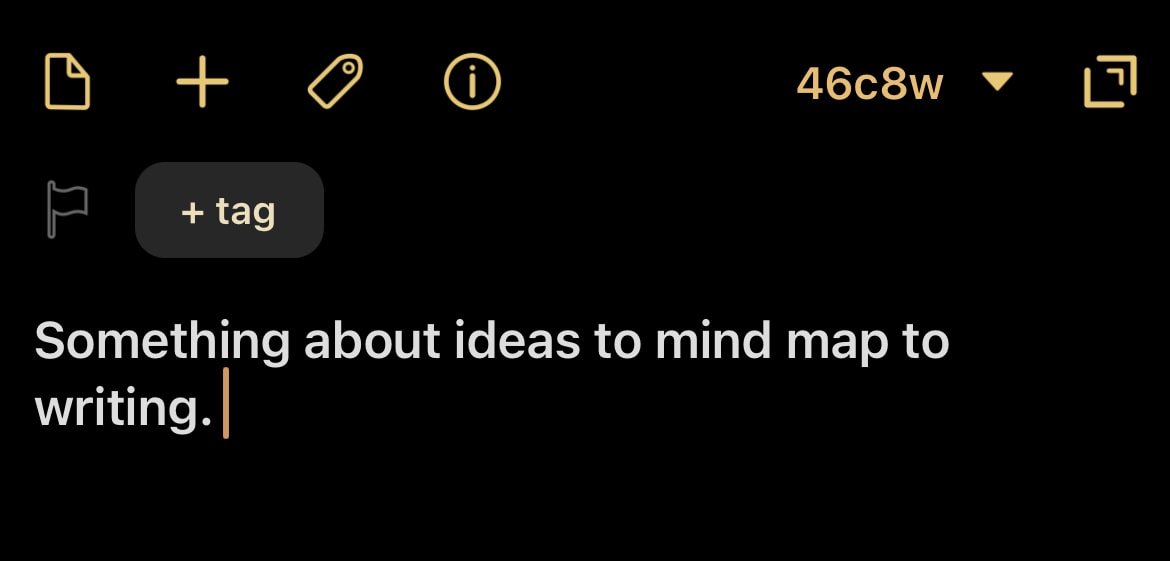
Again, Drafts is where I capture things. For you, it might be different and that is great. The important thing is to have somewhere fast and easy.
Then I want to put that idea somewhere where I can use it. Right now, I use an app called Ulysses for all my writing.
This idea was for an article (this article!), so I am going to dump it in a Ulysses Group I have set up called AE Blog Ideas.
I could manually copy the text over to Ulysses, but Drafts has wonderful automation features. I have a Drafts Action called Blog Post in Ulysses set up. In 2 taps, I will have this captured to the right place:

This idea is then captured and waiting for me in my AE Blog Ideas Group in Ulysses.

That idea may sit there for a few days, a few weeks, a few years, or it may never be turned into anything. That’s OK. The important part is to capture it so that when I go to write a blog article, it will be there waiting for me and I don’t have to hunt for it.
How can you help your “future you” by making it easy to use your idea when the right time comes?
The idea is waiting for me to build on it; develop it; turn it into something real.
Ideas, Automation, and Efficiency Systems
Is that automation I just showed required for capturing ideas? Of course not. However, I feel that having small automations like this are like lubrication that make gears turn more smoothly. They make everything a little faster, a little easier, and a little more likely for everything to just work.
We call these things efficiency systems, and if you’d like to see some more examples, we have a free masterclass available now. Click here to register.
Build Out & Develop Ideas 🏗
It is rare that an idea springs out of your mind fully formed like Athena from Zeus’ forehead.
It needs to be developed. Depending on what you are doing, this might take 5-10 minutes, or it could be a process of days, weeks, or even months.
There is no “best” way to develop ideas, but three effective methods are:
- Outline: A text-based, linear flow of points and subpoints.
- Mind Map: A visual, non-linear depiction of ideas
- Linked Notes: Notes using a Personal Knowledge Management tool like Obsidian or Roam Research that doesn’t rely on a hierarchy, but is instead built on connections.
We have recorded a podcast comparing outlines and mind maps, but the best way to find the approach that works the best for you is to try different methods and see which is the most natural.
Why I Like Mind Maps
The approach that works the best for me is a mind map — specifically a digital mind map.
You don’t need to use a digital tool; you can mind map effectively with paper.
However, you will see in our article that can help you learn to mind map that one of the big benefits of a digital mind map is that it lets you seamlessly move things around as you develop, or “cook” your idea.
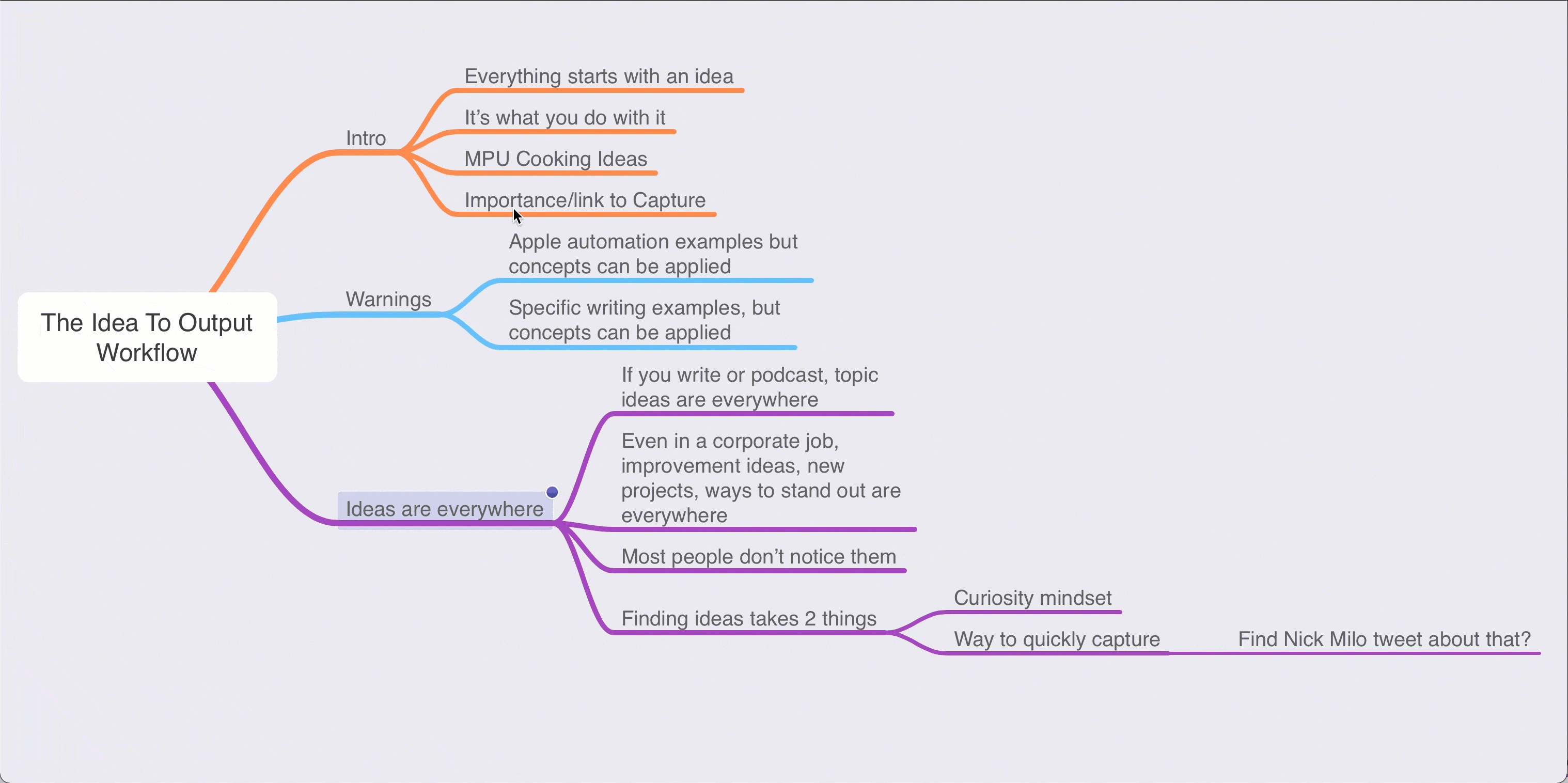
To develop ideas, that means getting down the big ideas first, then fleshing them out, then re-arranging things, then cutting things, then rinsing and repeating.
There are many great mind mapping apps like XMind (Windows, Mac, Mobile, Web), Mindmeister (Web, Mobile), or my favorite: MindNode (Mac, iOS).
Unfortunately, MindNode is Apple-only, but I like it because it is beautiful visually, works really well on my Mac, iPad, and iPhone and since I always have one of those devices with me, I can develop ideas wherever I am.
Mind Map Examples
A mindmap is a near-perfect brainstorming tool, and that is why a digital mind map is my go-to tool for developing ideas.
I can do the initial brain-dump phase and get everything out of my head and onto the map. Then I can do the refine-and-structure phase, moving things around and connecting them to develop them into something useful and actionable.
We have written articles in the past about mind map uses and how the team uses mind maps, but here are some ways that I use mind maps to develop ideas:
Presentations
A mind map helps to build out an effective and cohesive presentation.
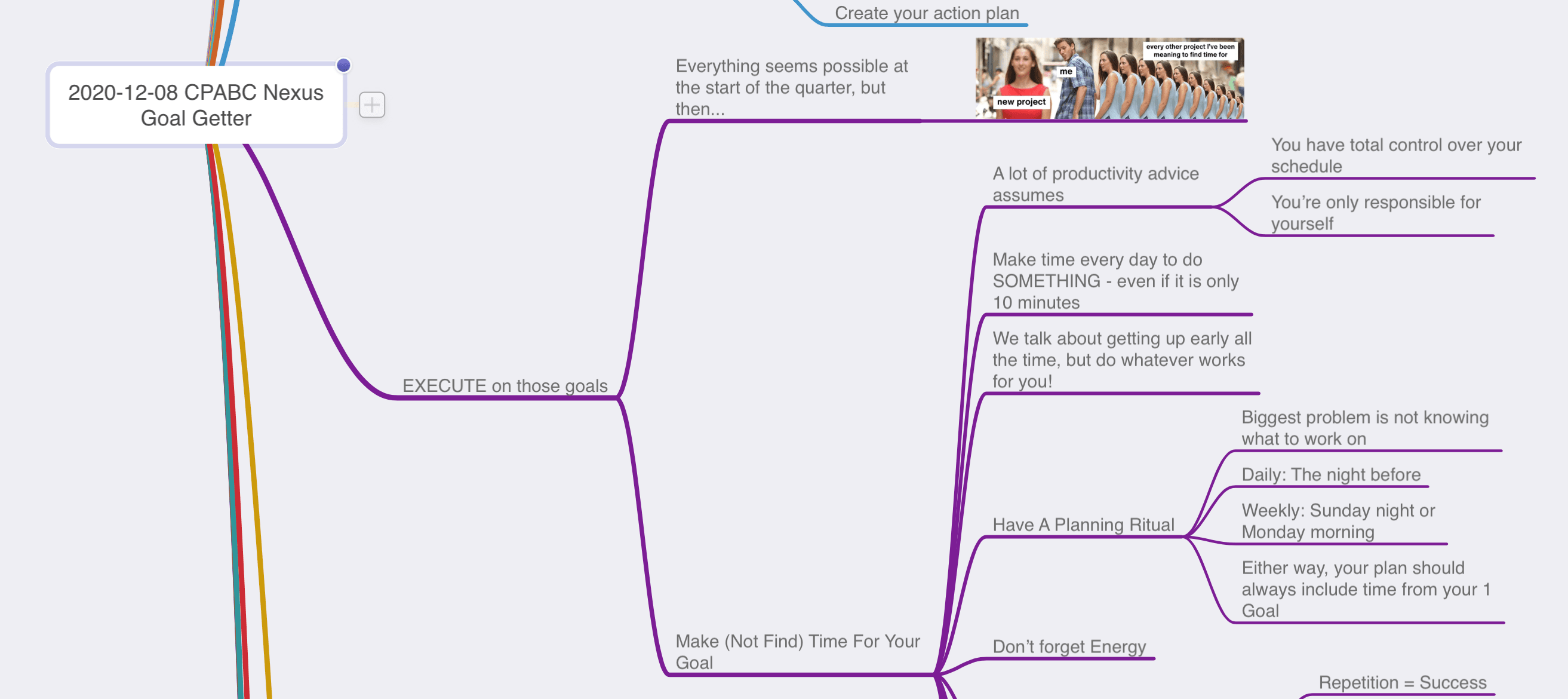
Training Plans
If I am going to do an in-depth training, like this one when I went to meet with the team in the Philippines, I mind map out the points I want to cover.
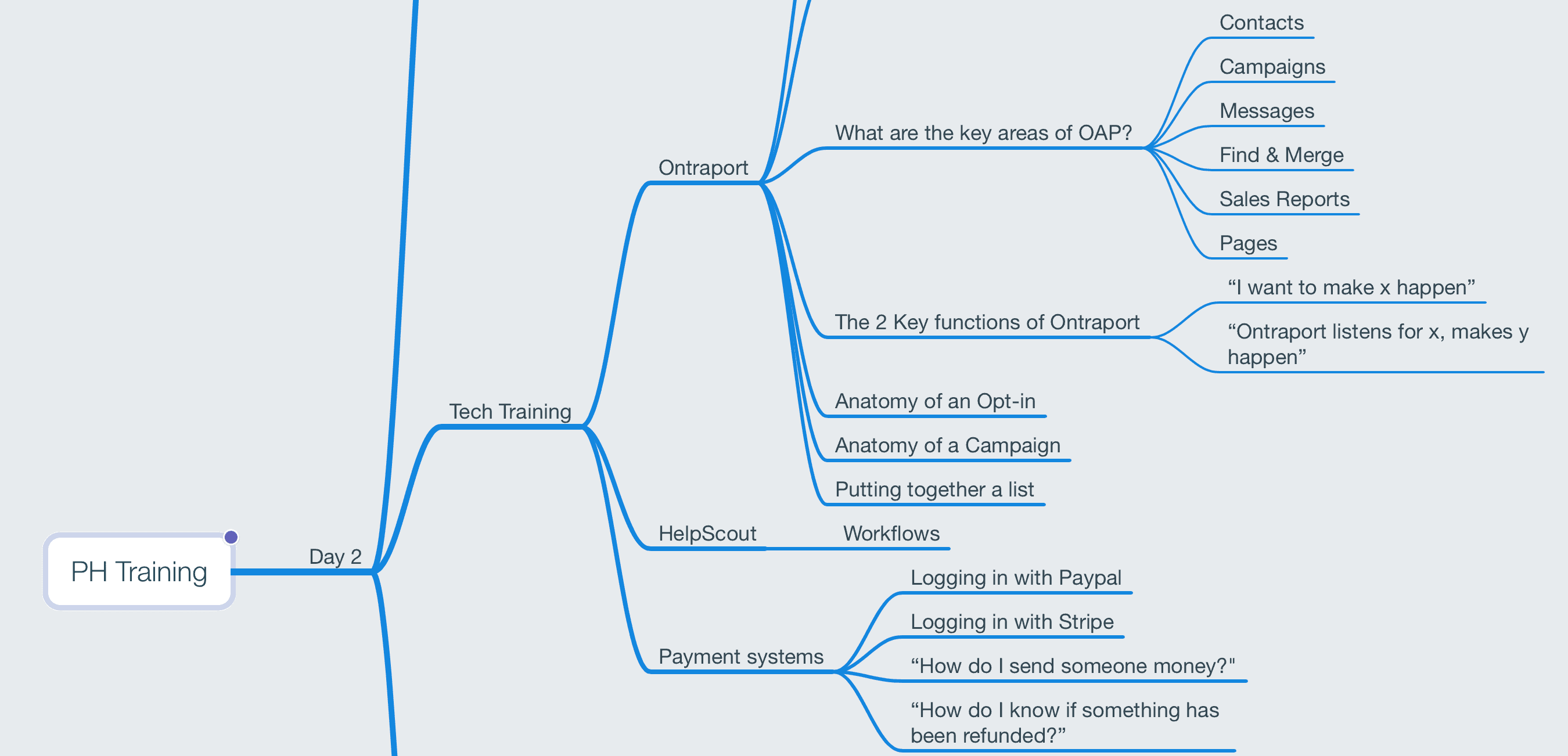
High Level “What Needs To Be Done” Initial Project Plans
Doing an initial brain dump/categorization using a mind map can be very helpful to develop an idea that results in a larger project.

Content Ideas
Being open to ideas is always important, but sometimes you just want to sit down and come up with a bunch of ideas at once. Mind maps are perfect for this.
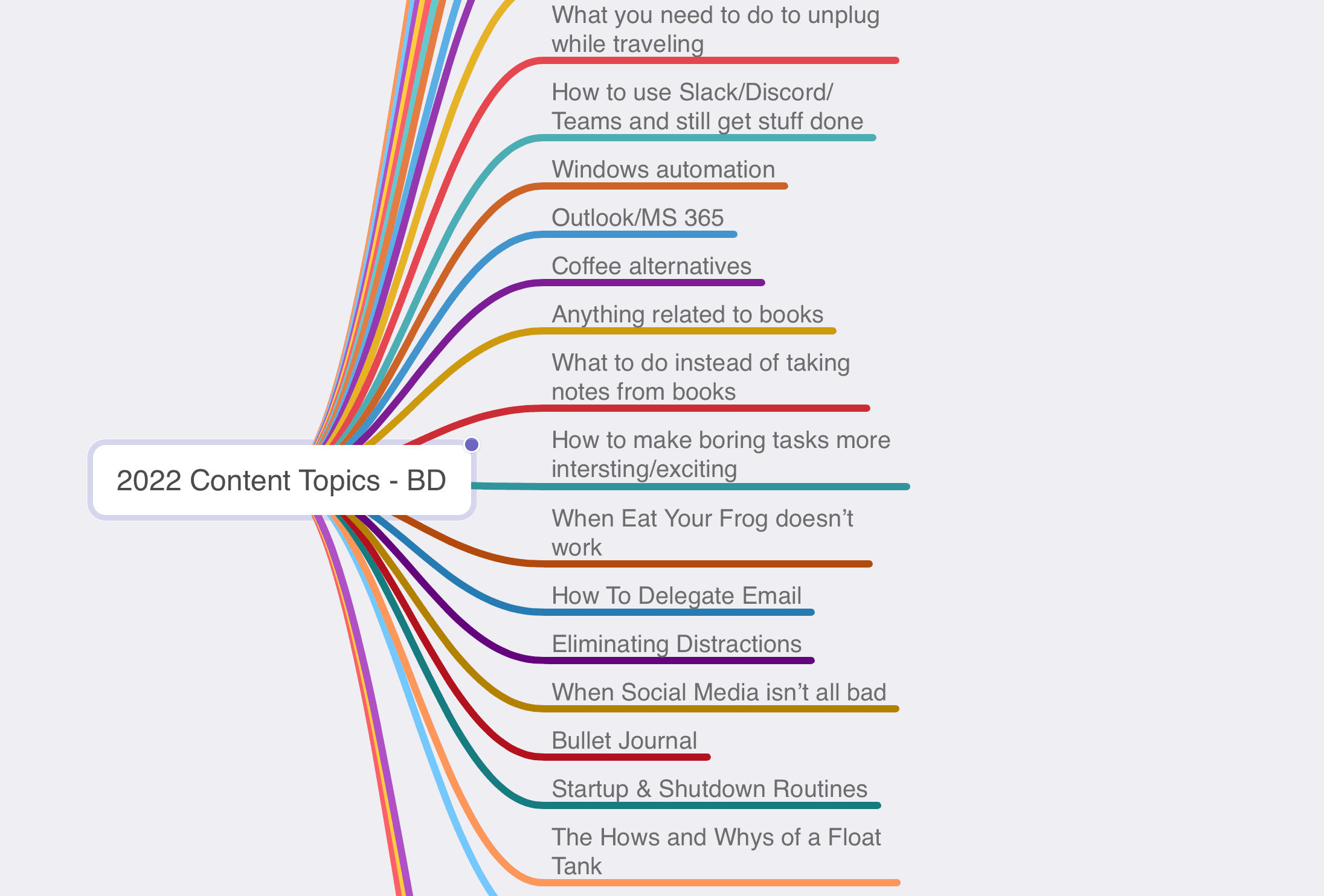
“Big Rocks”
Sometimes, it all gets too much. When things get overwhelming, it can be helpful to mind map out the “big rocks” that need to be done. You can then flesh them out/figure how the how once you have the what out of your head.
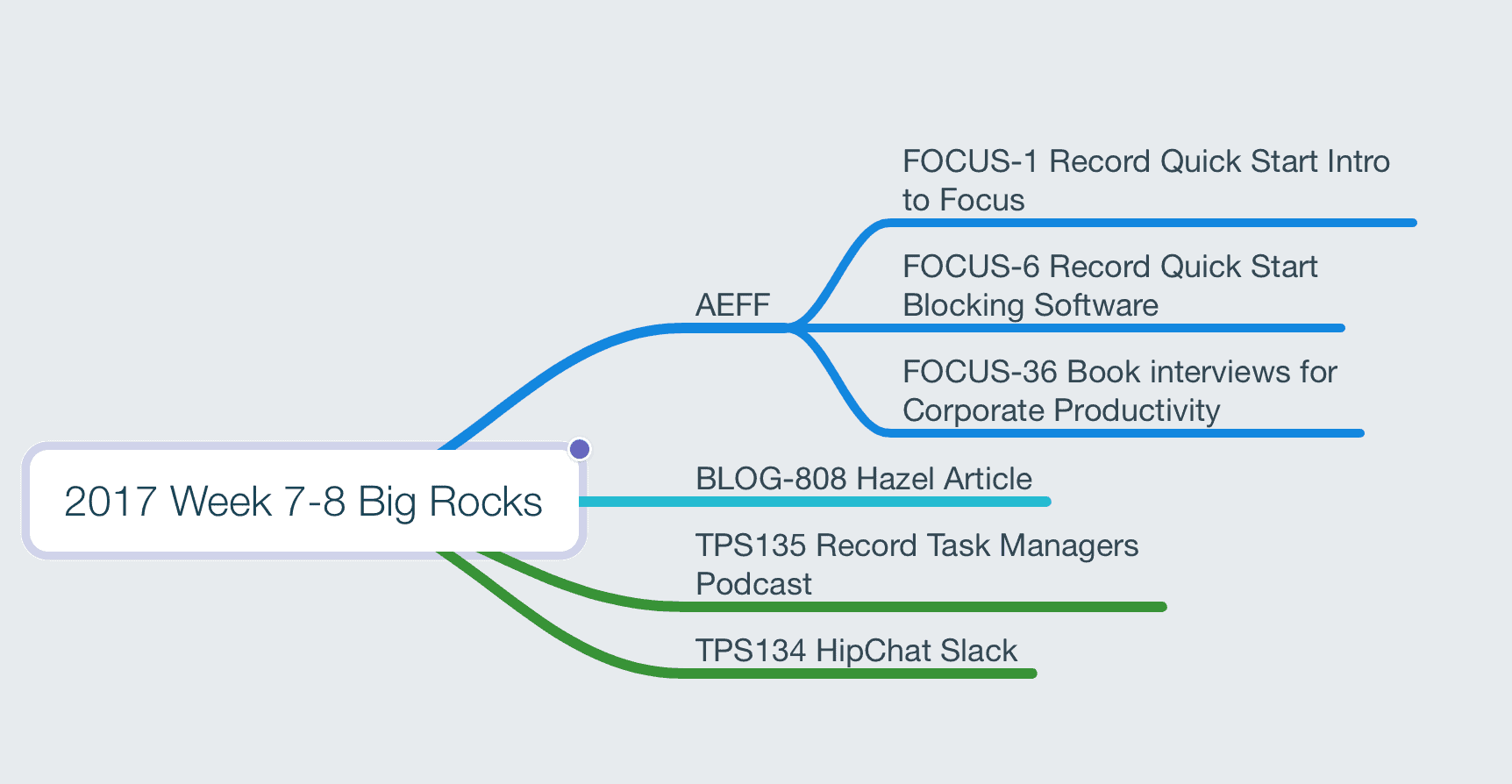
Book Notes
I wrote all about how I take book notes, and I use mind maps to do it. I can then take the map and decide what action items (if any) come next.
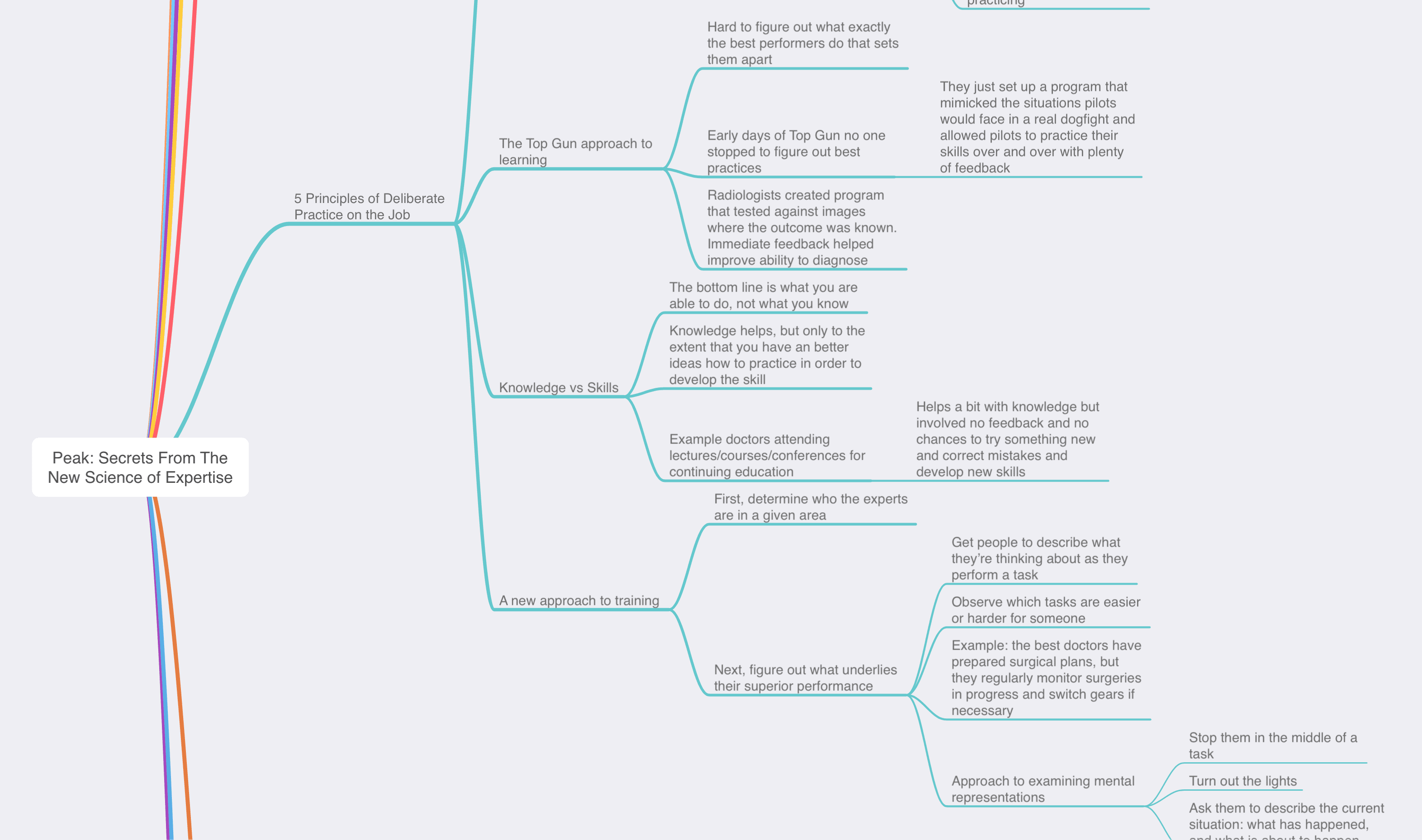
Example: This Article As A Mind Map
By this point, you will not be surprised to learn that this article, like any article, course, or complex podcast I create, starts as a mind map.
Here is how things looked before I started writing:
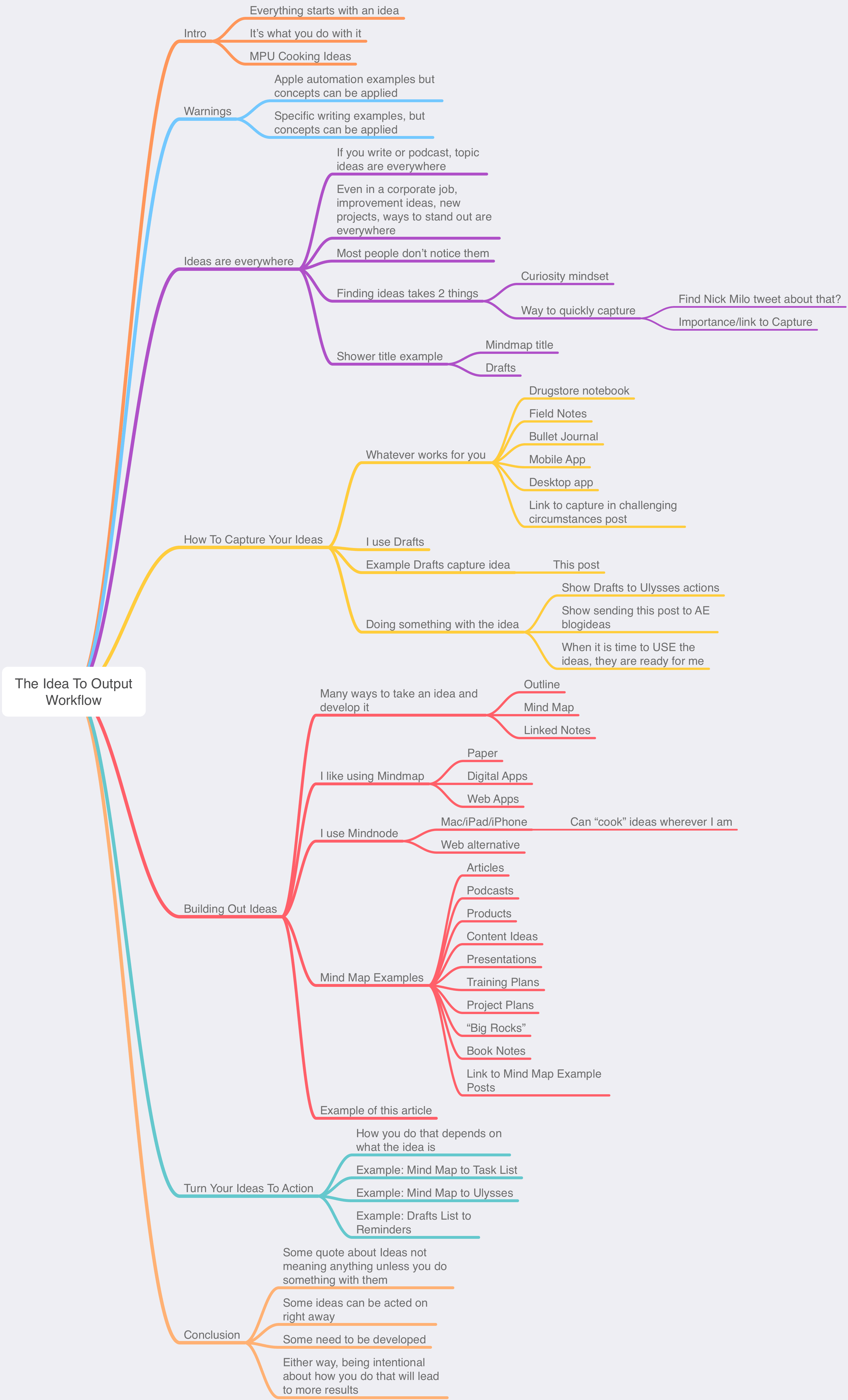
(Click here to see the image in full)
Side note: You may notice that all my mind maps don’t look “traditional”: they only go to the right and don’t have bubbles off to the left. I like them that way since usually I create things that wind up in sequential order.
I guess they are more like a hybrid mind map and outline. As with everything, try both ways and see what works best for you.
In MindNode, you can set everything to the right by going to Node > Organize > Move All Nodes to Right.
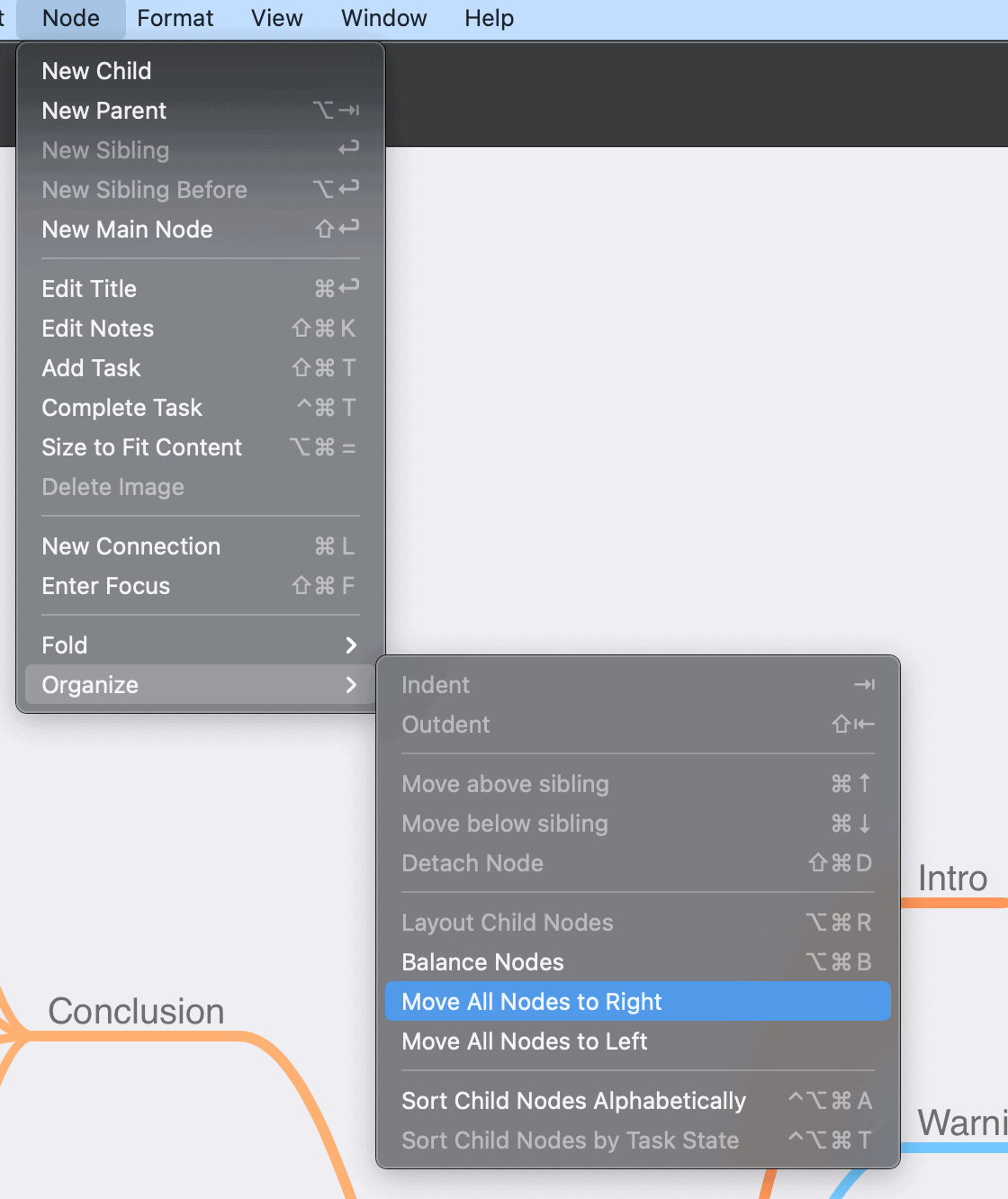
Turn Your Ideas To Action ⚡️
An outline, mind map, or linked note is a valuable resource, but you then need to take that developed idea and do something with it.
Of course, how you do that depends on what you have developed.
Having a fleshed-out version of your idea gives you a roadmap and head start for taking action.
Example: Mind Map to Task List
For example, let’s say you’ve created a mind map is a high-level project plan and contains tasks.
You can then take that structure and re-create it in your task manager or to-do app, and start working away.
In my case, my mind map app (MindNode) and my task manager (OmniFocus) can work together, and I can export my mind map directly to OmniFocus’ Inbox.
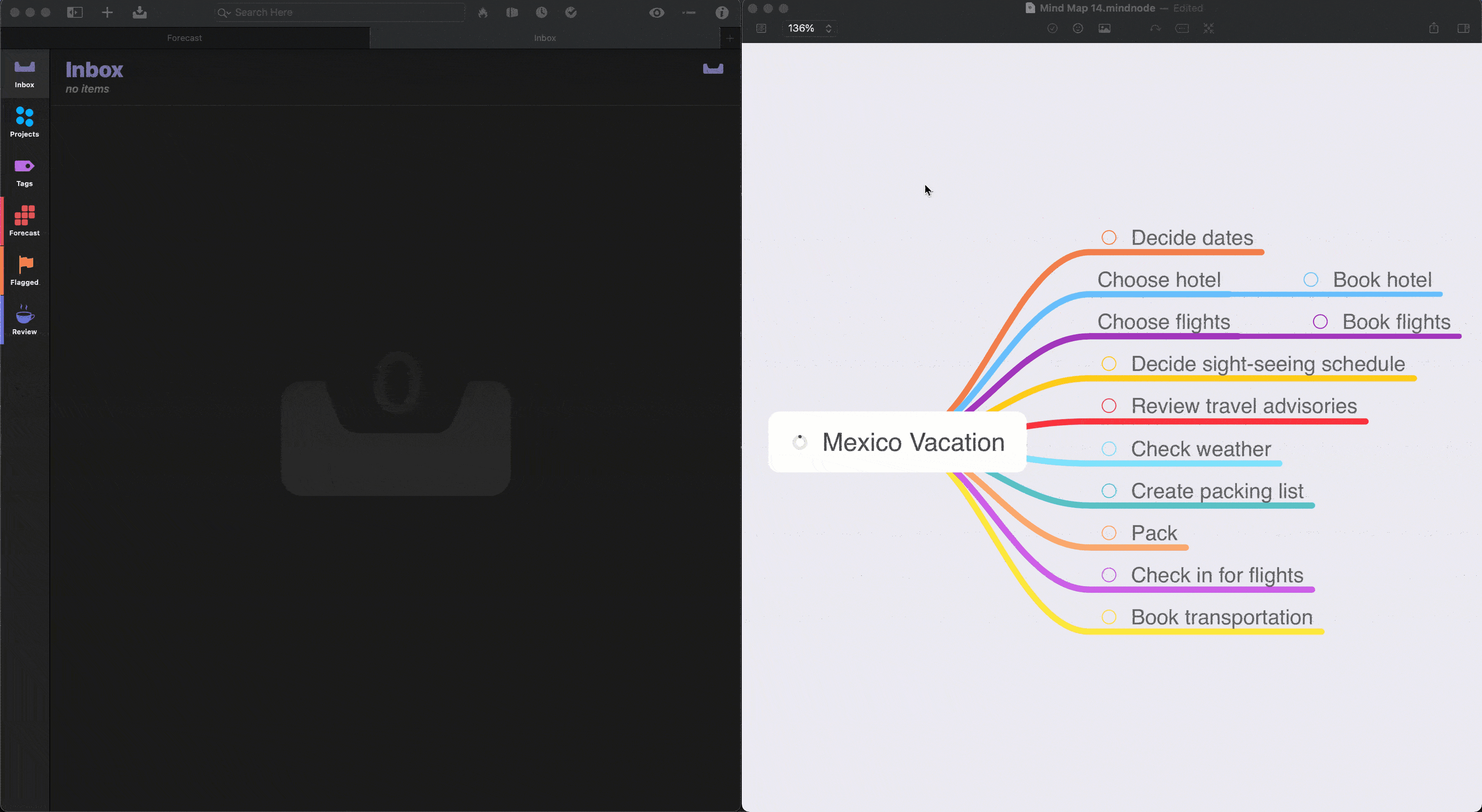
I value using tools that make my life easier.
Example: Mind Map to Writing App
If you are writing an article, script, newsletter, work document, or even a book, your mind map or outline will give you a structure to write from.
At the time of writing, I have the mind map for this article up on my second monitor so that I can refer to it as I write.
That is handy, but if your mind map or outline app supports it, you may be able to export your text and have your headings and subheadings ready to go.
For example, my app MindNode can export to a format that my writing app, Ulysses, supports. Here’s how I started writing this article:
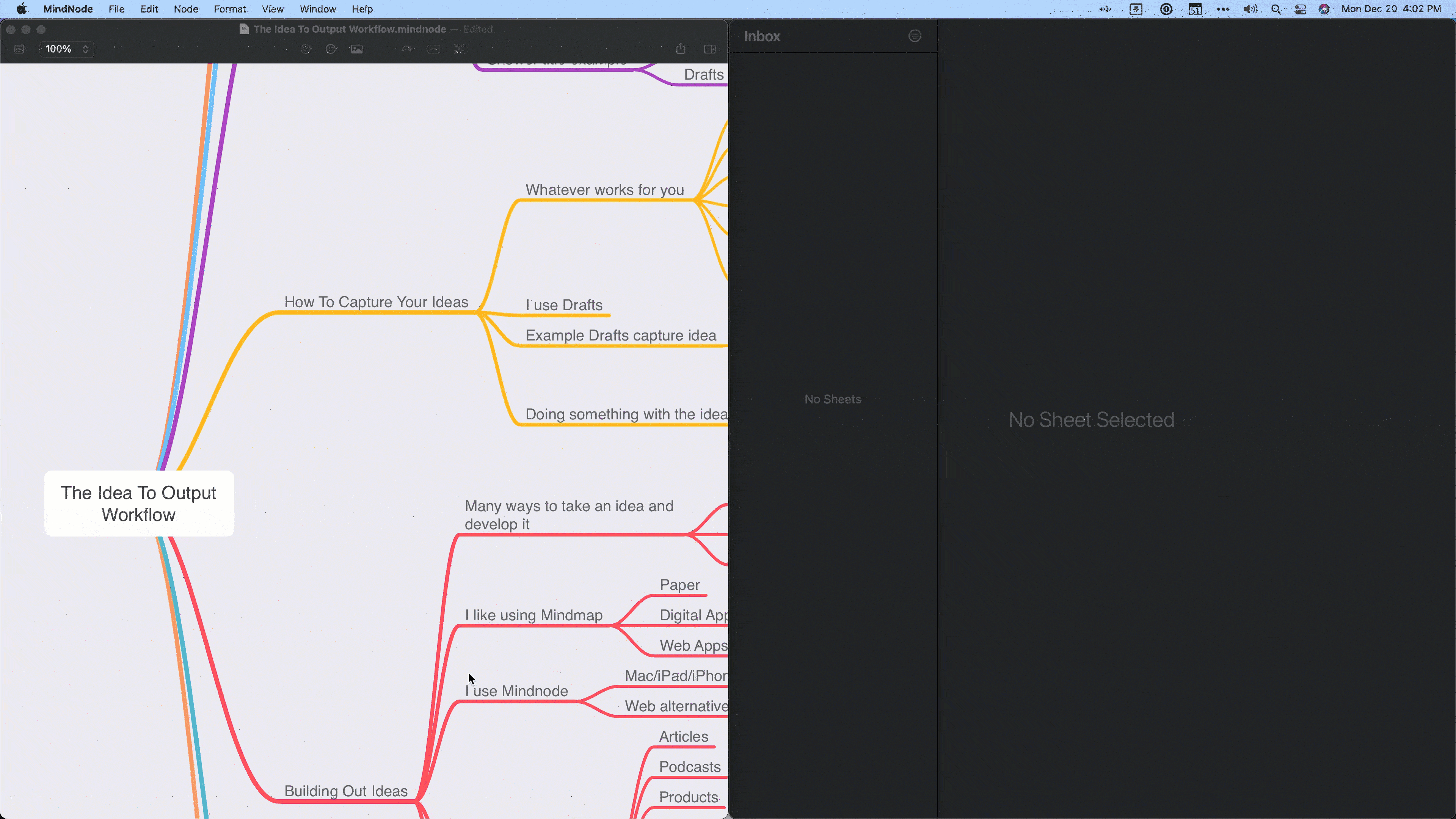
Everything was set up for me — I just needed to start writing!
If your mind map or outline app supports exporting in a format called Markdown, you may be able to do something similar. It’s a huge time and friction-saver.
Example: List to Reminders
Maybe you prefer to develop your ideas in a simple list, and you don’t need a fancy task manager; a simple to-do list is just fine.
You may be able to simply copy and paste your list to your to-do app, but if you use Drafts, you can send a list of text to the Apple Reminders app.

I do this a lot with a list of books I want to capture, or a list of things I want to buy.
How will you take action on your idea?
Lack of clarity is one of the root causes of procrastination. You have an idea or are given a task, and if you aren’t sure how to get started, things grind to a halt.
Some ideas can be acted on right away, and if you can get focused, you can have results quickly.
Other ideas need to be developed, and by being intentional about how you capture, develop, and take action, the more consistent and high-quality your results will be.
